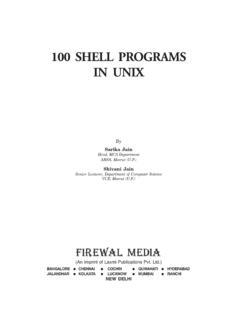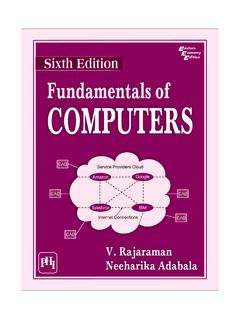Transcription of CASE STUDY FINANCIAL MANAGEMENT
1 case STUDY SoLUTIONS FINANCIAL MANAGEMENT case STUDY SoLUTIONS FINANCIAL MANAGEMENT SECOND EDITION Gr. CAPT. H. KAUSHAL, VSM (RETD) MACMILLAN Macmillan Publishers India Ltd, 2003, 2010 All rights reserved. No part of this publication may be reproduced or transmitted, in any form or by any means, without permission. Any person who does any unauthorised act in relation to this publication may be liable to criminal prosecution and civil claims for damages. First published, 2003 Reprinted, 2005-2009 (six imvres.~ions) Second edition, 2010 Reprinted. 101 1 MACMILLAN PUBLISHERS INDIA LTD Delhi Bangalore Chennai Kolkata Mumbai Ahmedabad Bhopal Chandigarh Coimbatore Cuttack Guwahati Hubli Hyderabad Jaipur Lucknow Madurai Nagpur Patna Pune Thiruvananthapuram Visakhapatnam Companies and representatives throughout the world ISBN 10: 0230-32944-6 ISBN 13.
2 978-0230-32944-7 Published by Amitabh Nagpal for Macmillan Publishers India Ltd, 3A, 5th Floor, DLF Corporate Park, Gurgaon 122 002 (Haryana), India Typeset by Arpit Printographers Printed at Rashtriya Printers 27B/2, Dilshad Garden, Delhi 110 095 This book is meant for educational and learning pwposes. The author{s) of the book has/have taken all reasonable care to ensure that the contents of the book do not violate any existing copyright or other intellectual property rights of any person in any manner whatsoever. In the event the author{s) has/have been unable to track any source and if any copyright has been inadvertently infringed, please notify the.}}
3 Publisher in writing for corrective action. To My Wife Neena herself an author of 18 books who taught me to accept and love a person as she is. She stood by me during decades of married life, made tougher by my faults. I started teaching MANAGEMENT over 25 years ago. It was easy to see that number of MANAGEMENT concepts appeared very simple to the students when taught in the classroom. Application of these very theories often, presented difficulties while solving practical corporate world problems. Similarly, MANAGEMENT principles were grasped quickly and correctly when these were linked to incidents from my work life of 50 years.
4 Normally, there should be only a small step from such teaching MANAGEMENT principles to solving of case studies. Unfortunately, it is not so. This is because the technique for solving case studies is usually not taught in business schools. There is also an acute shortage of case studies in FINANCIAL MANAGEMENT , especially with Indian background. Teaching MANAGEMENT by solving case studies has, therefore, been a casualty. Some institutions have even scraped teaching case studies because of this shortage! This book is an attempt at making good this vital deficiency. Three chapters in Part I deal with theoretical background of the case studies and general technique of solving a case STUDY .
5 The rest of the book contains case studies, divided into five parts. Parts II and III are for self- STUDY . Part II contains case studies, followed by complete suggested solutions and a case STUDY for exercise. Part III is to help slow learners. Complete solutions have been tapered to hints to the solution. This-part has case studies, hints to the solutions and a case STUDY for exercise. Part IV contains numerical problems, which are important for a student of FINANCIAL MANAGEMENT . viii Preface Part V consists of many case studies for classroom teaching. Lastly, Part VI narrates cases needing wider and comprehensive coverage.
6 These case studies are suitable for tackling by syndicates. Majority of the case studies have been set in the Indian environment and only some cases have been based on foreign surroundings. This is only to expose the readers appropriately. A serious attempt has been made to cover all facets of FINANCIAL MANAGEMENT theory through these case studies. Topics included in the syllabi of some other institutions like ICWAI, etc have also been covered. A number of cases have been drawn from the question papers of the MANAGEMENT and FINANCIAL institutions, universities etc across the country.
7 This is basically to give confidence to the students about the type of case studies usually included in the examination papers. It needs to be emphasized that the case STUDY solutions are certainly not meant for business schools . alone; practicing managers and those preparing for allied institutions will find the book equally useful. Briefly, brushing up the MANAGEMENT principle on which a case STUDY is based will help, not only in solving the case STUDY but also in understanding the theoretical concepts better. I must place on record the help and encouragement given by many individuals.
8 The foremost must be a number of persons from the publishers, M/ s. Macmillan (India) Ltd. I am purposely refraining from naming them. The best and most profound gratitude must be reserved for my students in the classrooms, colleagues (seniors, juniors and peers) in various organizations and many teachers from whom I got rhis knowledge. A number of friends from different cities have sent me examination papers and syllabi of the nearby universities/institutions. I thank them all for the help. I dedicate this book to my wife Neena Kaushal, herself a renowned author of 18 books. Our married life, spanning over four decades, has been no bed of roses by any stretch of imagination, but without her besides me, I with tones of faults, would have collapsed.
9 She taught me to love and accept a person, as she/he is. H. Kaushal FINANCIAL MANAGEMENT has got its rightful place in the hierarchy of MANAGEMENT specializations since about three decades. Earlier finances were expected to be handled by Chartered Accountants or people having a commerce background. Many professionals, from areas like engineering, computers, etc. have joined the FINANCIAL MANAGEMENT cadre. These individuals have often learnt one aspect of FINANCIAL MANAGEMENT and continued to operate in that limited field for many years. It is necessary for these people to broaden their understanding and learn about other aspects of FINANCIAL MANAGEMENT , as they become senior.
10 This book will help them obtain an all round practical knowledge, by solving the case studies, especially those meant for self- STUDY . Similarly, managers rising to senior positions in the company from various streams like production, marketing, HRD, etc. are at a disadvantage because their exposure to FINANCIAL MANAGEMENT is rather limited. It is unfortunate, but true, that many good, small and medium companies have had to see evil days because the owners did not have adequate knowledge about finance. These units were often too small to afford a finance manager and the owners were not confident about understanding the intricacies of FINANCIAL MANAGEMENT .












